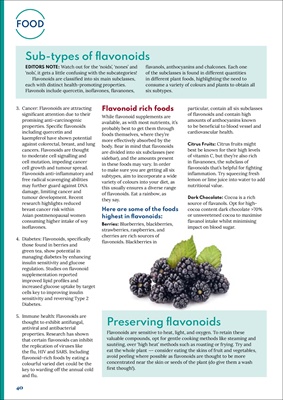
40
FOOD
3. Cancer: Flavonoids are attracting
significant attention due to their
promising anti-carcinogenic
properties. Specific flavonoids
including quercetin and
kaempferol have shown potential
against colorectal, breast, and lung
cancers. Flavonoids are thought
to moderate cell signalling and
cell mutation, impeding cancer
cell growth and tumour spread.
Flavonoids anti-inflammatory and
free radical scavenging abilities
may further guard against DNA
damage, limiting cancer and
tumour development. Recent
research highlights reduced
breast cancer risk within
Asian postmenopausal women
consuming higher intake of soy
isoflavones.
4. Diabetes: Flavonoids, specifically
those found in berries and
green tea, show potential in
managing diabetes by enhancing
insulin sensitivity and glucose
regulation. Studies on flavonoid
supplementation reported
improved lipid profiles and
increased glucose uptake by target
cells key to improving insulin
sensitivity and reversing Type 2
Diabetes.
5. Immune health: Flavonoids are
thought to exhibit antifungal,
antiviral and antibacterial
properties. Research has shown
that certain flavonoids can inhibit
the replication of viruses like
the flu, HIV and SARS. Including
flavonoid-rich foods by eating a
colourful varied diet could be the
key to warding off the annual cold
and flu.
Flavonoid rich foods
While flavonoid supplements are
available, as with most nutrients, it's
probably best to get them through
foods themselves, where they're
more effectively absorbed by the
body. Bear in mind that flavonoids
are divided into six subclasses (see
sidebar), and the amounts present
in these foods may vary. In order
to make sure you are getting all six
subtypes, aim to incorporate a wide
variety of colours into your diet, as
this usually ensures a diverse range
of flavonoids. Eat a rainbow, as
they say.
Here are some of the foods
highest in flavonoids:
Berries: Blueberries, blackberries,
strawberries, raspberries, and
cherries are rich sources of
flavonoids. Blackberries in
Sub-types of flavonoids
EDITORS NOTE: Watch out for the 'noids', 'nones' and
'nols', it gets a little confusing with the subcategories!
Flavonoids are classified into six main subclasses,
each with distinct health-promoting properties.
Flavonols include quercetin, isoflavones, flavanones,
flavanols, anthocyanins and chalcones. Each one
of the subclasses is found in different quantities
in different plant foods, highlighting the need to
consume a variety of colours and plants to obtain all
six subtypes.
particular, contain all six subclasses
of flavonoids and contain high
amounts of anthocyanins known
to be beneficial to blood vessel and
cardiovascular health.
Citrus Fruits: Citrus fruits might
best be known for their high levels
of vitamin C, but they're also rich
in flavanones, the subclass of
flavonoids that's helpful for fighting
inflammation. Try squeezing fresh
lemon or lime juice into water to add
nutritional value.
Dark Chocolate: Cocoa is a rich
source of flavanols. Opt for highcocoa
content dark chocolate >70%
or unsweetened cocoa to maximise
flavanol intake whilst minimising
impact on blood sugar.
Preserving flavonoids
Flavonoids are sensitive to heat, light, and oxygen. To retain these
valuable compounds, opt for gentle cooking methods like steaming and
sautéing, over 'high heat' methods such as roasting or frying. Try and
eat the whole plant ¬- consider eating the skins of fruit and vegetables,
avoid peeling where possible as flavonoids are thought to be more
concentrated near the skin or seeds of the plant (do give them a wash
first though!).